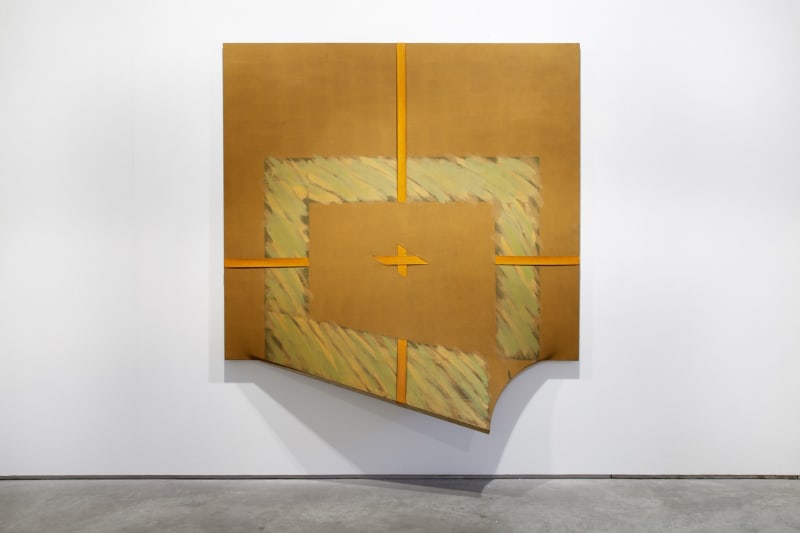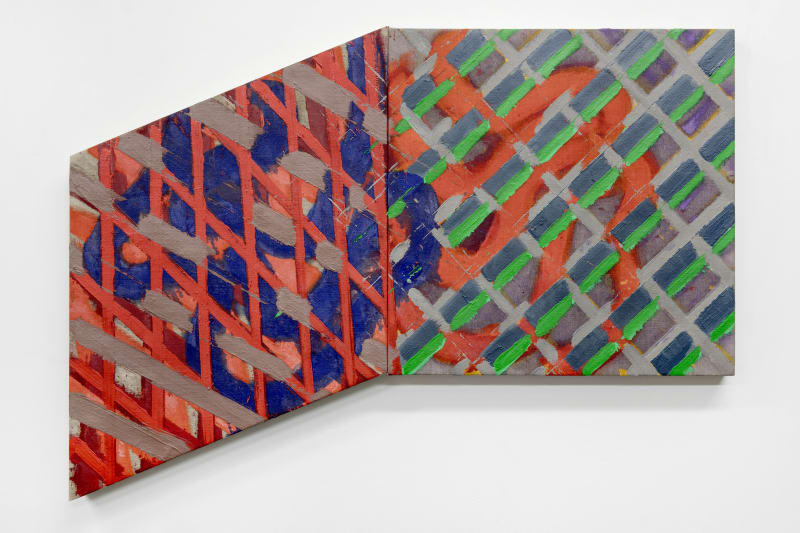Overview
Richard Smith (1931 – 2016) has been described as “one of the most original painters of his generation”, who enjoyed huge critical and commercial success in both Britain and the United States in the 1960s and 70s.* Smith stood apart from the burgeoning Pop Art movement of the 1960s by melding the slick and vibrant imagery found in the commercial landscape with an expansive abstract painterly style very much his own. This exhibition brings together works of five decades, including a mobile installation never previously exhibited in the United Kingdom and other rarely seen works from the artist’s estate.
The painting Red Label (1958) represents a turning point in Smith’s career as an artist, painted before leaving for New York on a Harkness Fellowship in 1959. The energetic and open brushwork, with its all-over rhythm and luminous density built from layers of translucent colour, relays the influence of American artist Sam Francis, and the Abstract Expressionist paintings he had seen exhibited at Tate in 1956. At the same time, as Chris Stephens (Head of Displays, and Lead Curator of Modern British Art, Tate) has acknowledged, his art “challenged and dispensed with the values at the heart of the American painting”, reflecting a new spirit of engagement with popular culture and the mass media.
In New York in the early 1960s, Smith created abstract works that shared a sensibility with the alluring colours and sheen of commercial packaging and advertising. Overwhelmed by the space and scale of his new urban surroundings, Smith took his visual cues from the glamorous images found on towering billboards and cinema screens, where the subjects represented were always larger than life. He observed “You could drown in a glass of beer, live in a semi-detached cigarette pack.”^ The painting Lee I transformed a segment of a jeans pocket into an enlarged, simplified form, composed of a vivid blue field intersected with bands of white. One of a duo of paintings produced in 1961 Lee I was first exhibited at the trailblazing Green Gallery, New York in 1963.
During the 1960s and 1970s, Smith extended the boundaries of painting into three dimensions, creating sculptural shaped canvases with monumental presence. Their contoured structures protruded into the space of the gallery exploring a radical new tension between volume, colour and surface. During this period, as the structure of his paintings became more complex, Smith’s use of colour was increasingly simplified, often concerned with achieving a sophisticated, dense glow with just one or two colours. He described his saturated, and often artificial tones as ‘ripening’, ‘shimmering’, and ‘blossoming’, reflecting the gloss of colour photography through the measured combination of matte tones. In Untitled 1 (1971), one of the last of the shaped canvases to be produced in Smith’s Butterfly series, the ‘drawing’ of the shape was determined by the stretcher, which extended into the space of the gallery in two sections, seen as continuous, linked picture planes. Here, the sections are identified by two shades of radiant yellow acrylic, enlivened by slight modulations of tone. Maryland (1972) is characterised by tapes woven through the painting to expose the fragility of the stretched canvas. In a much later work, Untitled (2002) Smith’s interest in the hidden grid-like warp and weft of the canvas is further accented by its interwoven construction at an enlarged scale.
A freestanding painted installation Gazebo exhibited at the Architectural League of New York in 1966, and a tent project at the Aspen Design Conference of the same year, led to the development of Smith’s renowned Kite paintings. First exhibited in New York in 1971, Smith replaced the bulky shaped stretchers with visible lightweight wooden or aluminium struts suspended from the wall or ceiling. The canvas was stretched and tied to the supports using strings, achieving a newfound tautness and levity such as that of a kite. On view in this exhibition, Madama (c.1980) and Round Flight (c.1985), demonstrate complex spatial relationships in which multiple components are unified by a continuous surface. Both works are constructed with rhythmic, overlapping shaped canvas planes, strings and struts, using an abstracted lexicon of forms derived from crosses, diamonds, zigzags and arcs.
During the 1980s and 90s, Smith realised his desire to generate site specific works, constructing installations in public and private spaces across the United States. Hanging in the upper gallery is the large-scale mobile installation Snakes and Windows (1993), on view in the UK for the first time. The installation was created for the exhibition Civic Virtues at Nations Bank Plaza, Charlotte, North Carolina, in 1994. Painted on both sides of the canvas, the floating abstract panels create subtly shifting relationships within the space.
From 1993 onwards Smith also returned to painting onto regular canvas supports, where the sense of internal shape was once again determined through the application of colour. His strikingly bold later abstract style demonstrated a greater contrast between increasingly positive, high-key colours. In works such as Red Valise (1995), the broad striations of red and pink created an off-register effect sometimes found in commercial printing, and could also be seen to echo the supporting structure of the rods and strings in Smith’s earlier kites. Untitled (2000), constructed as a square canvas panel fixed with a flat oblique extension, resembles the shape of a carton, which was a recurring motif in earlier paintings - this is also seen in Double Box (2010). Smith’s ideogrammatic, two-dimensional representations of carton-like structures shared the sensibilities, rather than replicated, the presentation of objects in modern life, an idea that sustained endless renewal in his paintings. According to Barbara Rose, Smith was an artist that “fit no mold... unique in his ability to not only revive and maintain the tradition, but also to push it forward to the point that it can stand with the most progressive, radical and inventive art of his time.” †
* Chris Stephens, Richard Smith Obituary, The Guardian, published in print on 21st May, 2016
^ Richard Smith, Statement of 1963, Published in the catalogue for the exhibition Richard Smith, The Jewish Museum, New York, 1968
† Barbara Rose, Richard Smith: The Incredible Lightness of Being, essay published in the exhibition catalogue Richard Smith: Kite Paintings, Flowers Gallery, New York, 2015
ABOUT RICHARD SMITH
Born in Hertfordshire in 1931, Richard Smith studied at the Royal College of Art, London from 1954-57. In 1959 Smith was awarded the prestigious Harkness Fellowship which facilitated his move to New York, where he had his first one man show at Green Gallery. Smith had a retrospective exhibition at the Whitechapel Gallery in 1966, while still in his thirties, and participated in some of the most important exhibitions of his time, such as Place at the ICA in 1959; Situation at RBA Galleries in 1960; and Painting and Sculpture of a Decade at Tate in 1964. After being awarded the Grand Prize at the 9th São Paulo Biennial in 1967 and participating in Documenta IV, Kassel in 1968, Smith represented Britain at the XXXV Venice Biennale in 1970, and was awarded the CBE in 1971. A major retrospective titled Seven Exhibitions 1961-75 was held at Tate in 1975. He joined Flowers Gallery in 2000. His work is held in the public collections of the Arts Council of Great Britain; The British Museum, London; Metropolitan Museum of Art, New York; the Museum of Modern Art, New York; Tate, London; Victoria and Albert Museum, London; Walker Art Center, Minneapolis; the Whitney Museum of American Art, New York; MIT, Boston; Philadelphia Museum of Art; Museum of Contemporary Art, Chicago; Hirshhorn Museum and Sculpture Garden, Washington, DC.


















